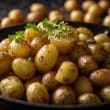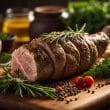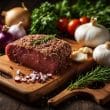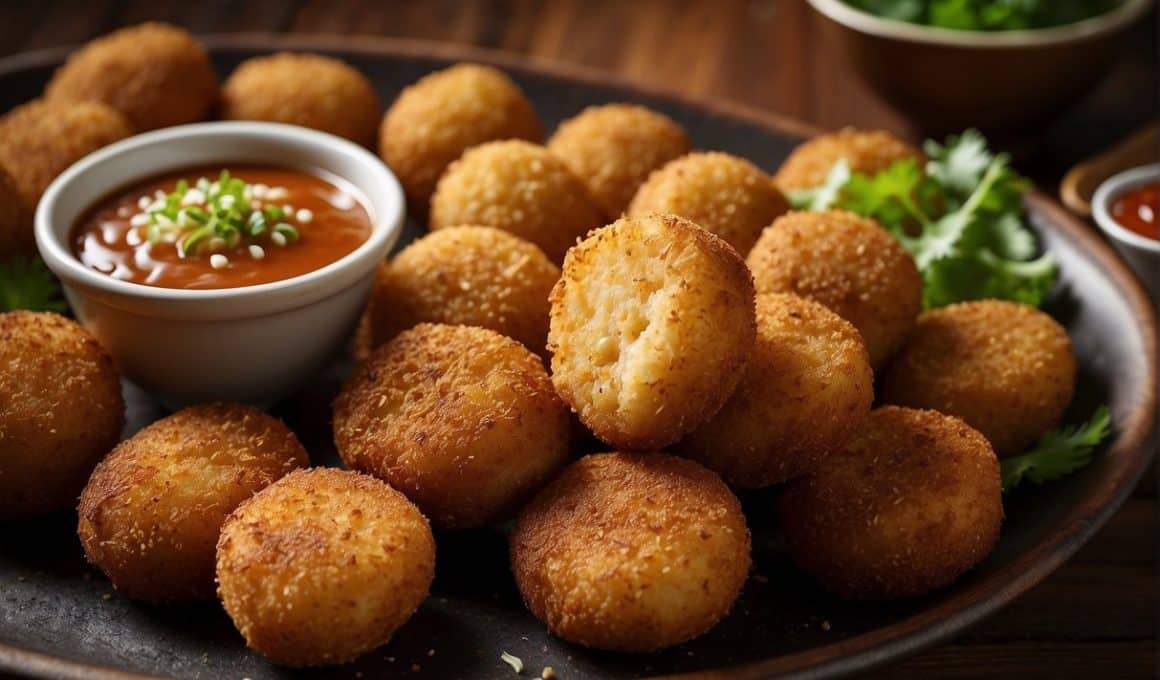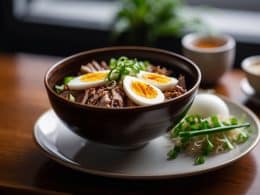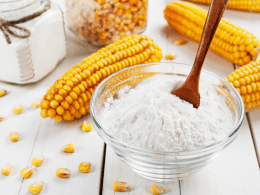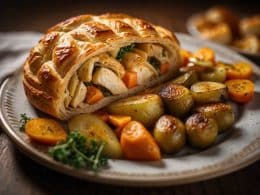Duck croquettes merge the rich flavors of duck meat with the pleasurable crunch of a perfectly fried exterior. Originating in Europe and often associated with Spanish cuisine, these bite-sized delights have now found their way onto global menus, appreciated for their versatility and the savory punch they pack. Made with tender, shredded duck encased in a light, crisp breadcrumb coating, duck croquettes are a sophisticated addition to any appetizer plate or party spread.
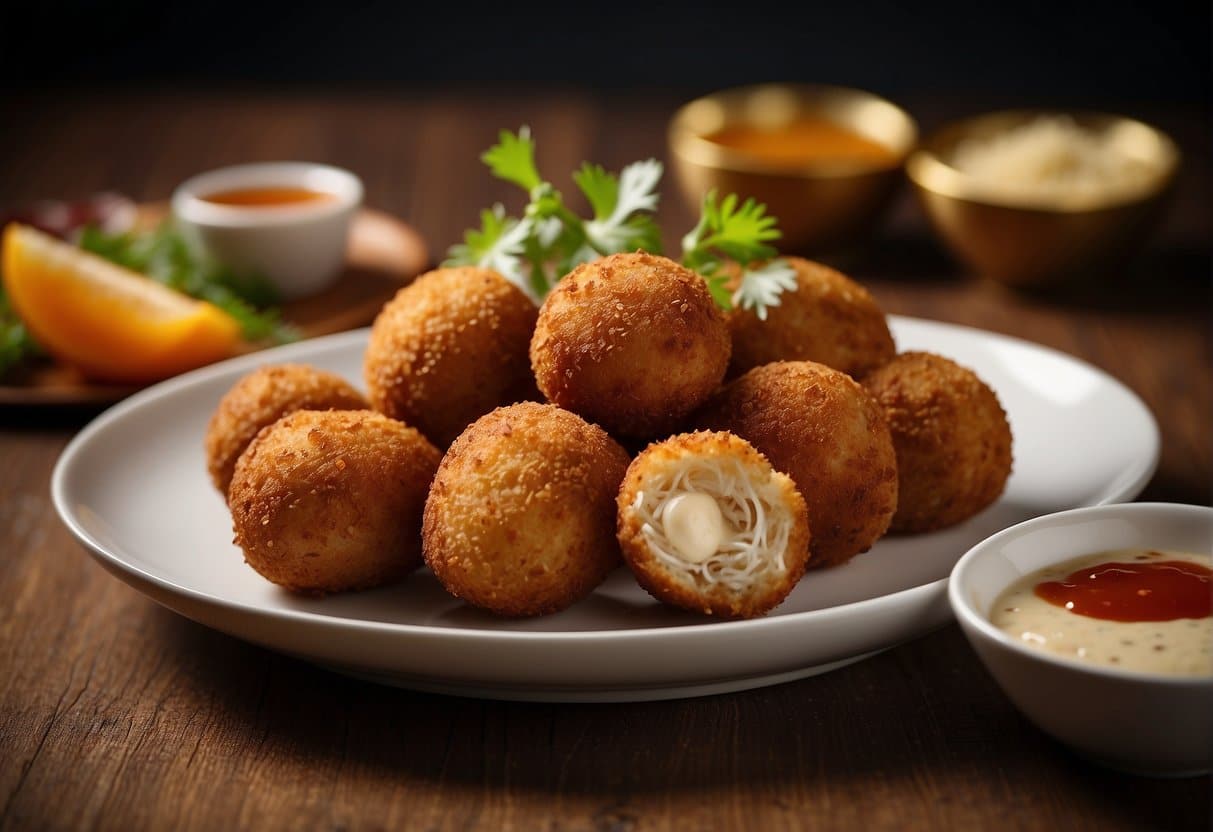
The journey to creating the perfect duck croquette begins with selecting quality ingredients. The duck, the star of the show, should be cooked until it’s succulent and easily shreddable. Complementary ingredients like nutmeg, mustard, and fine cheeses enhance the flavor profile and create a luxurious filling. The breading, usually a combination of flour, egg, and breadcrumbs, is the final step in preparing croquettes that boast a golden and crispy exterior. When it comes to cooking, methods such as deep-frying ensure that each croquette is evenly browned and has the desired texture to tempt any palate.
Key Takeaways
- Duck croquettes blend tender duck with a crispy coating for a satisfying appetizer.
- Quality ingredients and flavor pairings are fundamental for the best croquettes.
- Proper frying techniques are crucial for achieving a golden, crunchy exterior.
Duck Croquettes Overview
In this section, I will introduce you to duck croquettes, a delightful appetizer known for its crisp exterior and savory filling made from duck meat. These bite-sized snacks have earned a spot on gourmet menus and home kitchens alike.
What Are Duck Croquettes?
Duck croquettes are a sophisticated snack, typically featuring a mixture of tender shredded duck enveloped in seasoned breadcrumbs. The filling often includes additional ingredients like spices, herbs, or bechamel sauce to enhance the flavor. Once assembled, they are deep-fried to achieve a golden, crunchy crust that contrasts with the moist and flavorful duck meat inside.
The Popularity of Duck Croquettes
The popularity of duck croquettes extends beyond their taste. They serve as a versatile appetizer that fits seamlessly into a variety of culinary settings, from casual get-togethers to upscale dining experiences. The growing interest in international cuisine has also played a role in putting duck croquettes on the map as a sought-after snack, one that offers a welcome change from the usual fare.
Essential Ingredients
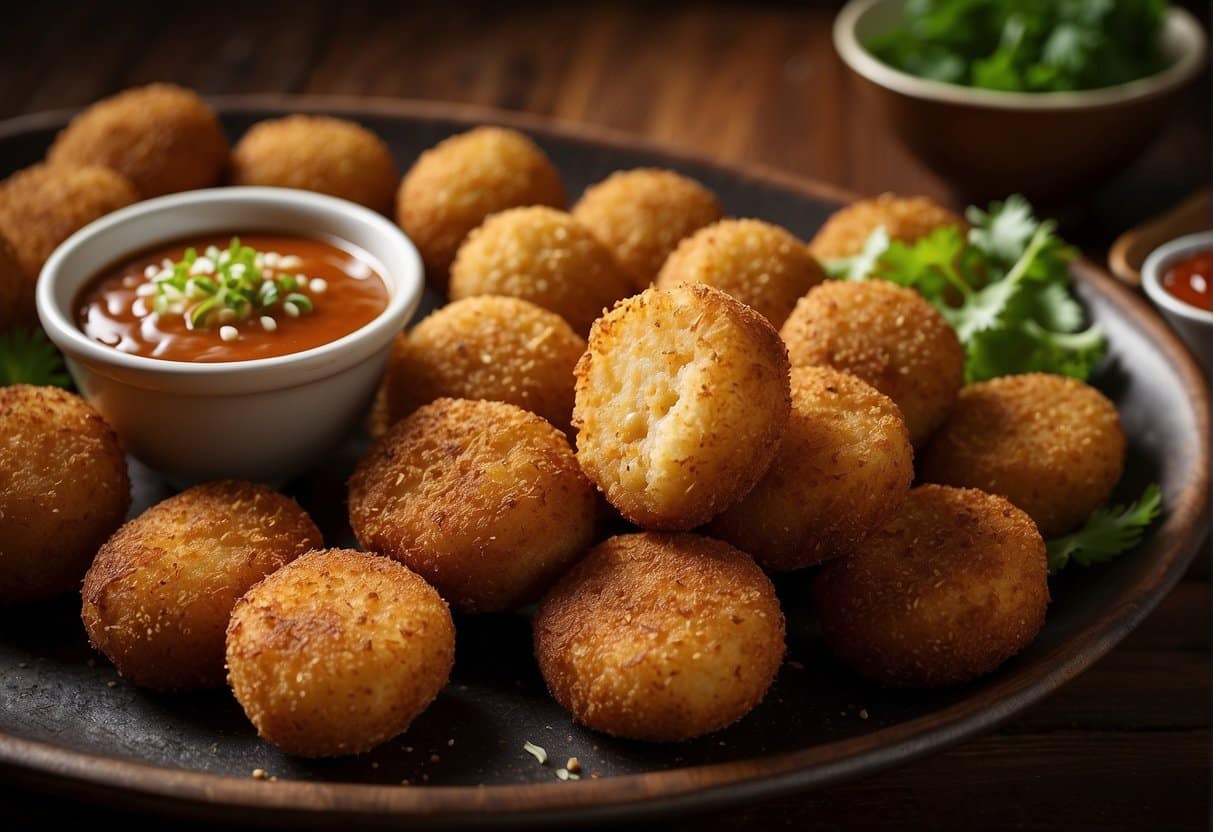
In my experience crafting the perfect duck croquettes, I’ve learned that a well-stocked pantry with the correct ingredients is crucial. The quality and proportion of these ingredients determine the texture and flavor of the final dish.
Primary Components
- Duck: At the heart of duck croquettes is, of course, succulent duck meat, often precooked and shredded. Having tasted croquettes with both fresh and left-over duck, I can say that either option works splendidly.
- Egg: Essential as a binding agent, eggs are key to helping the mixture hold its shape. I use eggs both within the croquettes and as an egg wash before breading.
- Breadcrumbs: For a textural contrast, breadcrumbs provide the crispy exterior. Panko breadcrumbs, known for their light, flaky consistency, are my go-to choice for that satisfying crunch.
- All-purpose flour: Works as the base for the croquette’s dough and is also useful for dredging. The gluten content in all-purpose flour lends the necessary elasticity and firmness.
- Oil: Reliable for frying, vegetable or sunflower oil ensures a golden-brown finish. I ensure it’s heated to the correct temperature to avoid greasy croquettes.
Seasoning and Flavor Enhancers
When it comes to seasoning, balance is paramount. Here’s how I season my croquettes for an optimal taste profile:
- Salt and Pepper: I use finely ground black pepper and sea salt for a consistent flavor distribution. Sea salt’s texture adds a subtle crunch.
- Spices and Herbs: A combination of spices like nutmeg, mace, and paprika add depth. I find that fresh or dried herbs such as thyme, parsley, and tarragon impart an aromatic quality that complements the duck. Nutmeg gives a warm note, whereas mace offers a more piquant aroma.
- Additional savory tones come from garlic, which I incorporate finely minced, and dairy elements like milk or butter contribute to the richness and aid in crafting a smooth bechamel for the base, if that’s the preparation method I employ.
By placing an emphasis on the integrity of these ingredients and the balance of flavors, I craft duck croquettes that are as delightful to eat as they are to prepare.
Preparation Basics
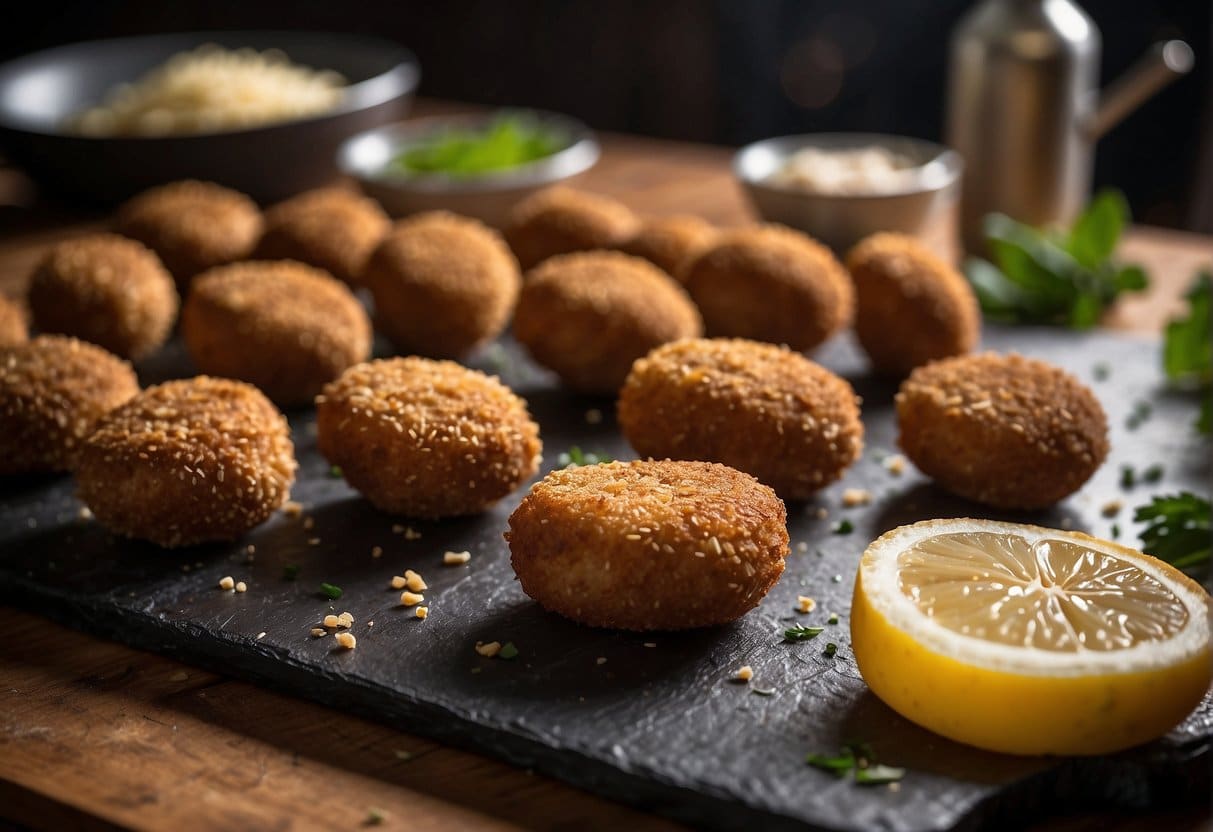
In this guide, I’ll walk you through the essential steps to create delicious duck croquettes, focusing on meat preparation, creating the mixture, and forming the croquettes for cooking.
Meat Preparation
To begin with the duck, I preheat the oven to a specific temperature that will thoroughly cook the meat without drying it out. Once the oven is ready, I prep my duck legs by ensuring that the skin is scored and seasoned. The duck legs are placed in the oven to roast until they’re perfectly cooked, which also allows the skin to crisp up nicely. After they’re done, I let them rest on a paper towel to absorb any excess oil. Once cooled, I debone the legs and finely shred the meat, making sure to remove all bits of bone for a smooth texture.
Creating the Mixture
Now, it’s time to start the base of my croquettes. I sauté finely chopped onion or shallot until translucent and then stir in plain flour to create a roux, which will thicken my mixture. Gradually, I add a liquid such as stock or milk while stirring to prevent lumps. Into this mixture, I incorporate the shredded duck, mashed potato, and seasonings like Dijon mustard, ensuring everything is combined evenly. If the mixture is too loose, additional plain flour can be added to achieve the desired consistency.
Forming Croquettes
Once my mixture is cooled and manageable, I shape it into small cylinders using plastic wrap to help form them uniformly. I then roll the shaped cylinders in plain flour, dip them into beaten egg yolk, and finally coat them with panko breadcrumbs for that essential crisp exterior. It’s crucial that each croquette is well-coated to avoid them falling apart when fried. After breading, the croquettes are chilled to set their shape before they’re ready to be cooked to golden perfection.
Cooking Techniques
In my experience, the success of duck croquettes hinges on the effectiveness of breading and frying methods. Proper technique can yield a crispy exterior with a succulent duck interior. Here’s how to achieve that.
Breading Methods
I’ve found the best breading for duck croquettes is typically a three-step process: flour, egg wash, then breadcrumbs.
- Flour: A light dusting of flour helps the egg wash adhere.
- Egg Wash: Beat eggs until smooth and dip the croquettes, ensuring even coverage.
- Breadcrumbs: For a golden brown finish, press the croquettes into breadcrumbs after the egg wash.
To keep my hands clean and the breading uniform, I use one hand for dry coatings and the other for wet.
Frying Guidelines
For the frying, I’ve learned that the choice of oil and pan can make a big difference.
- Choice of Oil: Vegetable oil and canola oil are my go-tos for deep frying due to their high smoke points.
- Frying Pan: I recommend using a deep frying pan to allow for ample space for the croquettes to cook evenly.
Here’s a brief step-by-step:
- Heat the oil to 350°F before adding the croquettes.
- Place them gently into the oil to avoid splashes.
- Fry until they’re golden brown, which typically takes about 4 minutes.
Once fried, I let them rest on a tray lined with paper towels to absorb excess oil. For those avoiding deep frying, an oven can also be used to bake the breaded croquettes on a tray until heated through and the outside is crisp.
Serving and Presentation
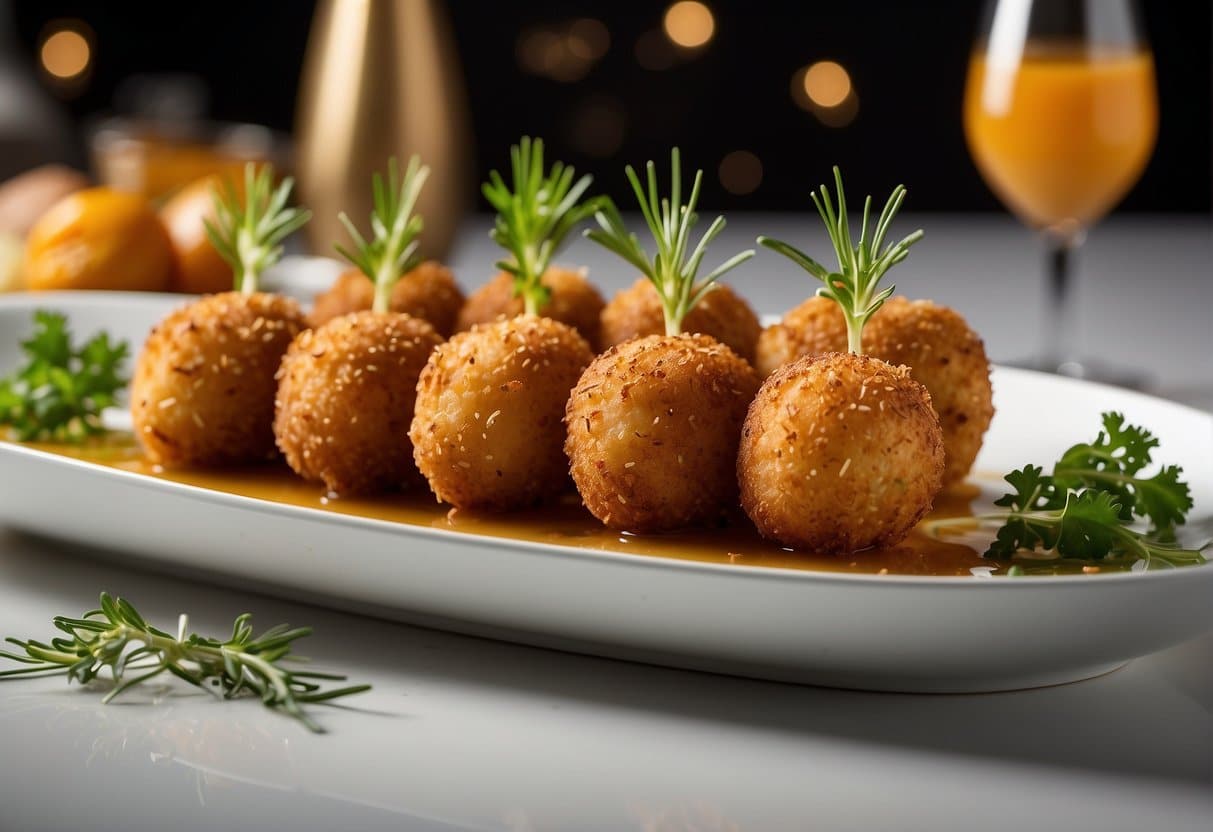
When I serve duck croquettes, I focus on the harmony of flavors and the visual appeal of the dish. Each element on the plate complements the nuanced taste and crisp texture of the croquettes.
Accompaniments and Dipping Sauces
The right accompaniments can transform duck croquettes into a culinary delight. I recommend serving these with a side of crisp green salad to add freshness. The salad not only offers a textural contrast but also balances the richness of the croquettes.
- Dipping Sauces:
- Creamy mayonnaise infused with garlic or herbs.
- Tangy sour cream enhanced with a sprinkle of chopped fresh parsley.
These sauces introduce a burst of flavor, making each bite intriguing.
Plating Suggestions
The presentation of duck croquettes should be as impressive as their taste. I use a white dish to make the colors pop. Here’s how I typically arrange the plate:
- Place a small bowl of dipping sauce on the side.
- Artfully arrange the croquettes on a dish in a circular pattern.
- Garnish with a sprig of parsley for a touch of color.
The combination of a meticulously plated dish and the perfect sauce selection promises a delightful dining experience.
Storage and Make-Ahead Tips
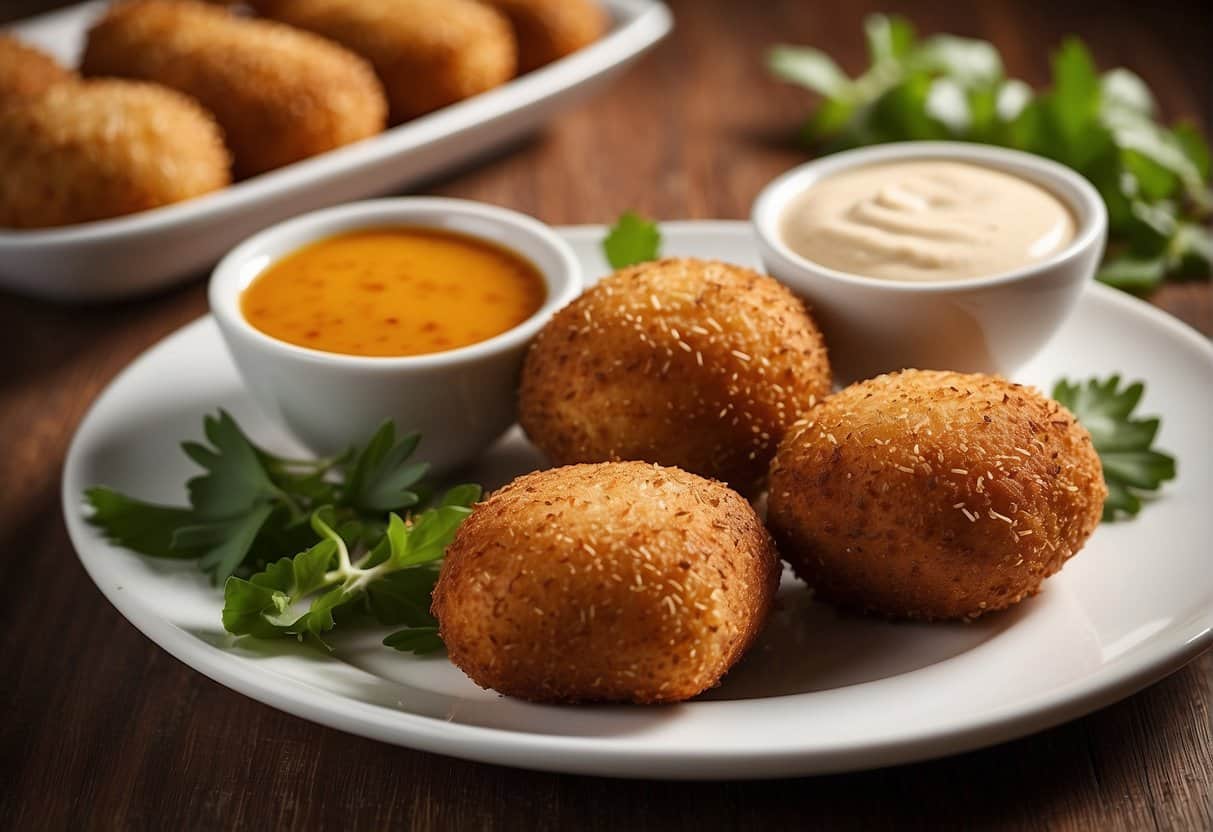
Duck croquettes, with their crispy exterior and savory filling, are a delightful prep-ahead dish that can make entertaining much easier. Proper storage is key to ensuring they retain their flavor and texture.
Refrigeration and Freezing
To refrigerate your croquettes, I recommend you first allow them to cool completely to avoid condensation inside the container which can make them soggy. Once cooled, place them in a single layer on a plate or tray lined with parchment paper, then cover with plastic wrap to prevent drying out. They can be refrigerated like this for up to 2 days.
For freezing, ensure the croquettes are spaced out to avoid them sticking together. Freeze them on a baking sheet before transferring them to a freezer-safe bag or container. They will keep well in the freezer for about a month, making them an excellent make-ahead dish for future use.
Reheating Instructions
To reheat, preheat your oven to 350°F (175°C). If they were frozen, there’s no need to thaw; simply add a couple of extra minutes to the reheating time. Arrange the croquettes on a baking sheet and warm them for about 10-15 minutes in the oven, or until they are heated through and the exterior is crisp. This method helps to restore the crunchiness without the need for additional frying.
Duck Croquettes Variations
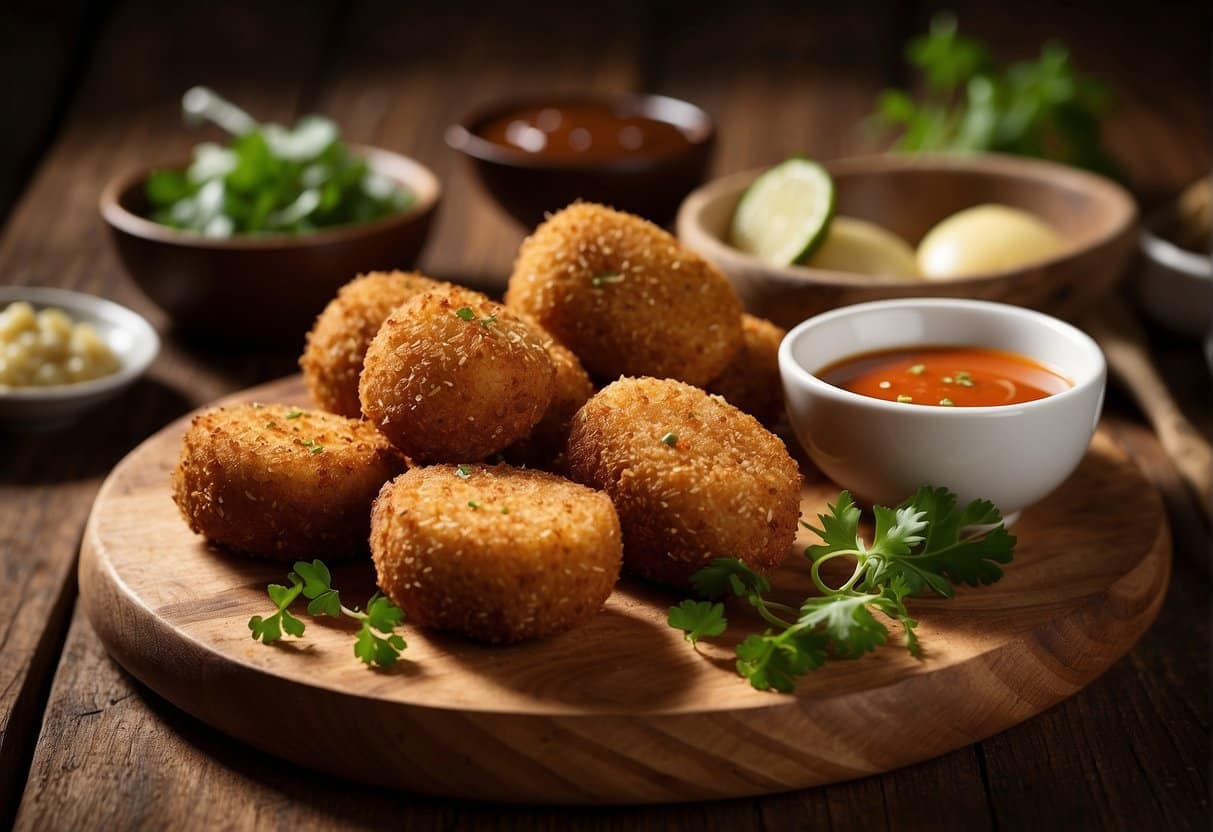
When I prepare duck croquettes, I find that there’s a delightful spectrum of variations I can explore, from global inspirations to swapping in alternative ingredients. This not only changes the flavor profile but can also cater to different dietary preferences or make use of the ingredients I have on hand.
Global Flavors
Confit Duck Legs: A staple in French cuisine, I often use confit duck legs for a rich and tender filling. By shredding the meat and combining it with herbs like thyme, I can infuse a traditional European essence into my croquettes.
- Italian Twist: I sometimes add mozzarella and sun-dried tomatoes to shredded confit duck for a Mediterranean flair.
- Asian Influence: A filling seasoned with soy sauce, five-spice, and green onions gives an aromatic Asian touch.
Chilli: Incorporating chilli peppers or chilli powder can dramatically transform the taste. I tend to add it sparingly for a subtle heat that complements the duck’s flavor without overwhelming it.
Alternative Ingredients
Russet Potatoes: I prefer using russet potatoes for the croquette base due to their fluffy texture after cooking, which binds well with the duck.
- Alternative: Sweet potatoes provide a healthful twist with their rich vitamins and fiber content.
Whole Milk & Bay Leaves: These ingredients are traditional for creating a creamy béchamel sauce that I use as a binding agent for my croquettes.
- Dairy-Free: For those avoiding dairy, I find that coconut milk is a great substitute to maintain creaminess.
Duck Fat: When available, I like to cook my fillings in duck fat to intensify the flavour. It adds a depth that’s unmistakably gourmet.
List of Alternatives:
- Olive oil for a lighter taste profile
- Rendered bacon fat for a smoky note
These variations cater to diverse palates and can be adapted based on the ingredients I find in my kitchen. Whether I’m aiming for duck confit croquettes with a classic taste or experimenting with global spices, the outcome is always a crowd-pleaser.
Health and Dietary Considerations
When preparing duck croquettes, I take into account both their nutritional benefits and potential allergens. My focus is on providing clear and factual health information.
Nutritional Information
Duck meat is a standout source of lean protein which is essential for muscle development and satiety. The protein content in duck can greatly benefit your diet, especially if you’re looking for lower-fat options compared to other meats. For example, a serving size can provide as much as 32.9 grams of protein which is essential for muscle growth and repair. In addition to protein, the calories in duck meat need to be considered; a typical serving contains about 281 calories. Being mindful of the portion sizes of duck croquettes can help in balancing the daily caloric intake.
Allergy Advice
When it comes to allergens, it’s crucial to be aware of the ingredients used in duck croquettes. Common allergens such as eggs, dairy products, and wheat may be present in the recipe. The eggs, for instance, not only serve as a binding agent but are also a known allergen for some individuals. Additionally, wheat is commonly found in the form of flour and breadcrumbs, which can pose a risk for those with gluten sensitivities or celiac disease. It’s my responsibility to make sure that the potential presence of allergens is clearly communicated for the safety and well-being of those who may have food allergies.
Where to Buy
When it comes to purchasing duck croquettes, I’ve found that you have a couple of solid options: supermarkets and specialty stores both offer various choices to satisfy your cravings for this delicious snack.
Supermarket Options
Major Grocery Stores:
- You can typically find frozen duck croquettes in the frozen meats section.
- Look out for brands like Maple Leaf Farms, which offers a Whole Duck with Orange Sauce, also a good base for making homemade croquettes.
Local Chains:
- Certain regional chains might stock fresh or frozen options in the deli or specialty freezer sections.
Specialty Stores
Gourmet Food Shops:
- Specialty food stores often carry artisanal duck croquettes; these are usually of higher quality and feature a variety of seasonings.
Online Retailers:
- For convenience, online stores like King Cole Ducks sell a range of duck products, including the ingredients to make duck croquettes at home.
Butcher Shops:
- Lastly, I recommend checking with local butchers, especially those who specialize in poultry, as they might offer pre-made croquettes or can provide fresh duck meat for making your own.
Making Duck Croquettes at Home
When I make duck croquettes at home, I focus on a balance of flavors and textures. To achieve this, I use certain cooking liquids like water and milk for the potato base and sometimes chicken stock to enrich the filling. My goal is to share tips and advanced techniques to ensure your croquettes are delightful.
DIY Cooking Tips
For homemade duck croquettes, water is essential for boiling the potatoes until they’re tender. I make sure the water is well-salted, similar to the method described by King Cole Ducks for achieving the right texture in the filling. To get that creamy béchamel-like mixture, which will hold the duck and other fillings together, milk is my go-to ingredient. I use full-fat milk because it adds richness, as suggested by Gressingham Duck. A sprinkle of sugar can sometimes enhance the natural flavors, though it’s not always necessary.
- Ingredients to Prepare:
- Cooked and shredded duck
- Russet potatoes, cubed and boiled
- Full-fat milk for creaminess
- Chicken stock for added depth
- Seasonings including smoked paprika
Advanced Techniques
When it comes to adding a sophisticated touch to my duck croquettes, I utilize advanced techniques such as incorporating a pinch of smoked paprika to give the filling a subtle smoky essence without overpowering the duck. Additionally, a well-reduced chicken stock can concentrate flavors and add a savory note that complements the richness of the duck.
- Techniques to Master:
- Reducing chicken stock to intensify flavor.
- Incorporating smoked paprika for complexity.
By sticking to these details, my duck croquettes turn out flavorful with a perfectly crispy exterior every time.
Contact and Support
In this section, I’ll provide you with direct avenues for customer service assistance and feedback for duck croquettes. You can reach out via various channels detailed below to ensure your concerns and suggestions are heard.
Customer Service
Email: For inquiries or support, email me at [email protected]. I aim to respond within 24 hours.
Phone: Call me at (123) 456-7890 between 9 AM and 5 PM EST, Monday through Friday.
Live Chat: Visit my website for live chat support during business hours.
Feedback Channels
Online Form: Fill out the contact us form on our website to leave your feedback.
Social Media: Send your thoughts directly through platforms like Twitter or Facebook; I’m available at @DuckDelights.
About the Author
As an avid food enthusiast and experienced culinary writer, I dedicate my energy to exploring the diverse realm of international cuisine. With years of practice in the kitchen and working alongside seasoned chefs, my passion lies not only in creating delicious dishes but also in sharing culinary knowledge with eager readers. My expertise expands through various types of cuisine, with a particular fondness for the intricate art of French cooking.
In my journey, I have had the pleasure of crafting numerous recipes, including the delectable Duck Croquettes, which have become a favorite among my repertoire. With each article, I strive to deliver content that is:
- Informative: Providing practical tips and culinary insights.
- Engaging: Keeping readers captivated with interesting food facts.
- Reliable: Ensuring each recipe is tried and tested for the best results.
My commitment goes beyond the kitchen as I actively participate in culinary workshops and contribute to food and wine magazines. This has allowed me to stay up-to-date with food trends and continue my lifelong education in gastronomy. Moreover, I have a strong background in nutrition, which helps me create balanced and health-conscious recipes.
Here are a few key points about my culinary journey:
- Professional Writer: Contributing insights to respected food publications.
- Recipe Developer*: Innovating new culinary delights, especially in appetizers and entrées.
- Workshop Facilitator: Educating budding cooks in hands-on cooking classes.
- Culinary Advisor: Consulting for restaurants on menu development.
My mission is simple: to inspire and empower home cooks with the confidence to explore diverse flavors and to make every meal an occasion to remember.
Additional Resources
In this section, I will guide you through valuable resources for enriching your knowledge and expertise in making duck croquettes. Whether you prefer a physical book in your hands or the quick accessibility of online articles, these resources are excellent for both beginners and experienced cooks.
Cookbooks and Guides
For those who seek a comprehensive understanding, there are several cookbooks and culinary guides that thoroughly cover the art of preparing duck and related dishes. These books typically offer step-by-step instructions, photos, and tips for perfecting croquettes:
- Duck Cookery: A Chef’s Guide by Martin Picard
- The Waterfowl Cuisine Compendium by Emma Lewis
These handpicked titles provide not only recipes but also delve into techniques that can elevate your cooking skills.
Online Articles
Numerous online articles provide insightful tips, variations, and even the history of duck croquettes. I find these particularly useful for quick references and discovering new ideas:
- Duck Croquettes – King Cole Ducks offers a step-by-step recipe and garnish suggestions for an aromatic experience.
- For creative twists on traditional recipes, How to Make Duck Croquettes from State Bird Provisions provides inspiration and detailed instructions.
These articles are just a click away, making them a practical choice for mid-cooking consultations or casual reading.
Frequently Asked Questions
In this section, I’ll cover some of the most common inquiries regarding the preparation and cooking techniques required for making delicious duck croquettes.
How do you prepare the classic duck croquettes?
To prepare the classic duck croquettes, I start with boiling diced russet potatoes until tender, then mash them while hot. I blend the mashed potatoes with shredded duck confit, season to taste, and shape the mixture into croquettes before coating them in breadcrumbs.
What are some tips for making duck croquettes like the great British chefs?
A key tip for making duck croquettes on par with great British chefs is to ensure the béchamel sauce used for the croquette filling is rich in flavor, seasoned with mustard powder, and paprika, which adds depth to the taste.
Can you provide a simple and easy recipe for making duck croquettes at home?
Certainly. An easy recipe starts with combining cooked, shredded duck with mashed potatoes and seasoning. Form this into croquettes, roll in flour, dip in beaten eggs, and coat with breadcrumbs. Finally, fry them until golden brown for a simple, homemade duck croquette.
What are the steps for making confit duck croquettes?
For making confit duck croquettes, cook confit duck legs as directed, shred the meat, and mix with puréed potatoes. Shape the mixture, roll in breadcrumbs, and fry until they are crisp and golden.
How can you incorporate oriental flavors into duck croquettes?
To infuse oriental flavors into duck croquettes, I add spices like five-spice powder to the duck mixture and serve with a side of oriental dip, such as hoisin sauce or a spicy mayonnaise blend.
Is egg an essential ingredient for binding croquettes before frying?
Yes, egg is essential as a binding agent for croquettes before frying. It helps hold the ingredients together, ensuring the croquettes do not fall apart when I fry them.


